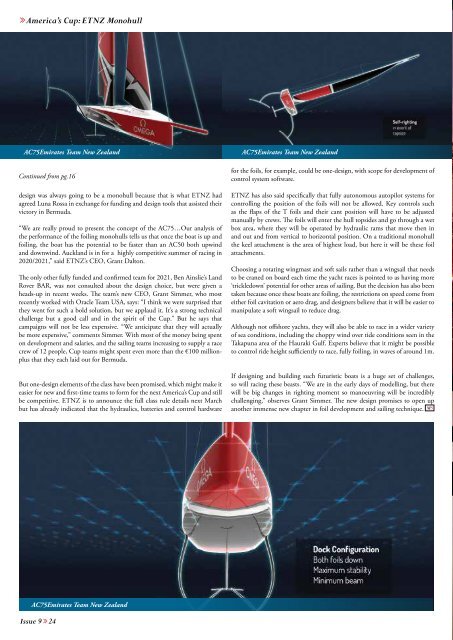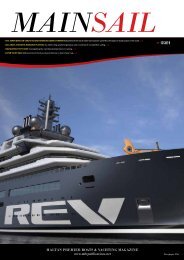MAINSAIL_ISSUE 9 FULL
Create successful ePaper yourself
Turn your PDF publications into a flip-book with our unique Google optimized e-Paper software.
America’s Cup: ETNZ Monohull<br />
AC75Emirates Team New Zealand<br />
Continued from pg.16<br />
design was always going to be a monohull because that is what ETNZ had<br />
agreed Luna Rossa in exchange for funding and design tools that assisted their<br />
victory in Bermuda.<br />
“We are really proud to present the concept of the AC75…Our analysis of<br />
the performance of the foiling monohulls tells us that once the boat is up and<br />
foiling, the boat has the potential to be faster than an AC50 both upwind<br />
and downwind. Auckland is in for a highly competitive summer of racing in<br />
2020/2021,” said ETNZ’s CEO, Grant Dalton.<br />
The only other fully funded and confirmed team for 2021, Ben Ainslie’s Land<br />
Rover BAR, was not consulted about the design choice, but were given a<br />
heads-up in recent weeks. The team’s new CEO, Grant Simmer, who most<br />
recently worked with Oracle Team USA, says: “I think we were surprised that<br />
they went for such a bold solution, but we applaud it. It’s a strong technical<br />
challenge but a good call and in the spirit of the Cup.” But he says that<br />
campaigns will not be less expensive. “We anticipate that they will actually<br />
be more expensive,” comments Simmer. With most of the money being spent<br />
on development and salaries, and the sailing teams increasing to supply a race<br />
crew of 12 people, Cup teams might spent even more than the €100 millionplus<br />
that they each laid out for Bermuda.<br />
But one-design elements of the class have been promised, which might make it<br />
easier for new and first-time teams to form for the next America’s Cup and still<br />
be competitive. ETNZ is to announce the full class rule details next March<br />
but has already indicated that the hydraulics, batteries and control hardware<br />
AC75Emirates Team New Zealand<br />
for the foils, for example, could be one-design, with scope for development of<br />
control system software.<br />
ETNZ has also said specifically that fully autonomous autopilot systems for<br />
controlling the position of the foils will not be allowed. Key controls such<br />
as the flaps of the T foils and their cant position will have to be adjusted<br />
manually by crews. The foils will enter the hull topsides and go through a wet<br />
box area, where they will be operated by hydraulic rams that move then in<br />
and out and from vertical to horizontal position. On a traditional monohull<br />
the keel attachment is the area of highest load, but here it will be these foil<br />
attachments.<br />
Choosing a rotating wingmast and soft sails rather than a wingsail that needs<br />
to be craned on board each time the yacht races is pointed to as having more<br />
‘trickledown’ potential for other areas of sailing. But the decision has also been<br />
taken because once these boats are foiling, the restrictions on speed come from<br />
either foil cavitation or aero drag, and designers believe that it will be easier to<br />
manipulate a soft wingsail to reduce drag.<br />
Although not offshore yachts, they will also be able to race in a wider variety<br />
of sea conditions, including the choppy wind over tide conditions seen in the<br />
Takapuna area of the Hauraki Gulf. Experts believe that it might be possible<br />
to control ride height sufficiently to race, fully foiling, in waves of around 1m.<br />
If designing and building such futuristic boats is a huge set of challenges,<br />
so will racing these beasts. “We are in the early days of modelling, but there<br />
will be big changes in righting moment so manoeuvring will be incredibly<br />
challenging,” observes Grant Simmer. The new design promises to open up<br />
another immense new chapter in foil development and sailing technique. MS<br />
AC75Emirates Team New Zealand<br />
Issue 9 >> 24
















